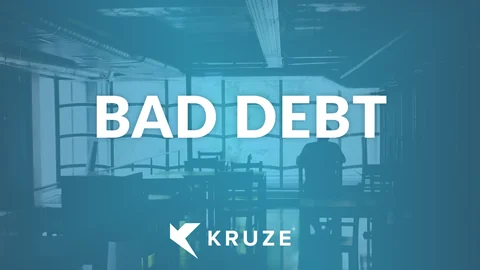
For startups, every dollar counts. While some debt can be a strategic tool for growth, bad debt – money owed to your business that is unlikely to be collected – can cloud the picture of your company’s financial health. Understanding the impact of bad debt and implementing strategies to prevent it is essential for your startup’s long-term success.
What Is Bad Debt and How Does It Arise?
Bad debt typically occurs because customers are unable or unwilling to pay what they owe. This situation often arises when startups extend credit to customers, but those customers later experience financial difficulties, such as bankruptcy or insolvency, or have issues with the goods or services provided. Other common causes include economic downturns, poor credit assessments, and inefficient collection processes.
Bad debt enters the picture when companies sell products or services on credit, record the expected payment as accounts receivable (A/R), but then find that some customers fail to pay part or all of the amount owed. Despite repeated collection efforts, these overdue receivables may remain unpaid and be written off due to the customer’s financial distress, disputes, or negligence.
The Process of Writing Off Accounts Receivable
When it becomes clear that an account receivable is uncollectible, the company must formally write off the amount from its books to accurately reflect its financial position. There are two main methods for writing off bad debt:
- Direct write-off method. The company recognizes the bad debt expense only when a specific account is determined to be uncollectible. Your accountant will debit your Bad Debt Expense account (part of your chart of accounts) and credit Accounts Receivable, removing the uncollectible amount from the books.
- Allowance method. The company estimates bad debt in advance, creating an allowance for doubtful accounts. When a specific account is deemed uncollectible, the entry is to debit Allowance for Doubtful Accounts and credit Accounts Receivable.
Startups typically use the direct write-off method to account for uncollectible accounts, also known as bad debt. This approach is simpler and more straightforward, allowing the company to write off bad debts only when a specific account is determined to be uncollectible, rather than estimating bad debt in advance as required by the allowance method. The direct write-off method involves fewer transactions and less forecasting, making it easier for startups without extensive accounting resources to manage bad debt expenses.
The write-off process typically involves:
- Identifying overdue and uncollectible accounts using aging reports and communication history
- Attempting further collection efforts, such as reminders or using collection agencies
- Obtaining internal authorization to write off the account
- Making the appropriate journal entries to remove the receivable from the balance sheet and recognize the loss
Writing off bad debt keeps your startup’s financial statements accurate and not overstated. Your statements will also reflect the true value of your assets.
How Bad Debt Impacts Startups
Put simply, bad debt is cash your startup was counting on that’s not going to arrive. That reduces the funds you were counting on to have available for essential operating expenses. The accumulation of bad debt over time can seriously damage your finances, reduce your creditworthiness, and limit your access to financing or funding. Bad debt can:
- Strain your cash flow: Bad debt directly reduces the cash available for expenses like payroll, inventory, and utilities. When expected payments don’t arrive, startups may struggle to meet their financial obligations, leading to liquidity issues and operational disruptions.
- Limit your growth: When writing off expected customer collections on services already rendered, startups may lack the resources and budget to invest in new products, marketing, or planned hiring.
- Damage your credit: When you struggle to collect from your own customers or have to write off receivables, it can create a trickle-down effect into your own finances. Failing to pay your creditors on time – often a consequence of cash flow problems caused by bad debt – can hurt your business’s credit rating. This makes future borrowing more expensive or even impossible, and can affect your reputation with suppliers and customers.
- Increase operational stress: Managing bad debt and chasing overdue payments is stressful for founders and employees alike.
- Put your startup at risk: If bad debt accumulates, startups may be forced to cut costs, downsize, or in the worst cases, declare bankruptcy.
Proven Strategies to Prevent Bad Debt
And while your startup probably can’t eliminate bad debt risk, you can take steps to significantly reduce your exposure:
1. Assess customer creditworthiness.
- Run credit checks on every new customer before extending credit, especially in B2B transactions.
- Review payment histories and look for red flags like late payments or prior bankruptcies.
2. Set and enforce realistic credit limits.
- Only offer as much credit as a customer’s financial situation justifies.
- Regularly review and adjust credit limits as relationships and circumstances change.
3. Define clear payment terms.
- Clearly state payment terms, due dates, and penalties for late payments in all contracts and invoices.
- Communicate these terms upfront and require customers to agree to them before doing business.
4. Monitor receivables and payment patterns.
- Use accounting software to track invoices and flag overdue accounts.
- Watch for changes in customer payment behavior and act quickly when issues arise.
5. Use deposits and upfront payments.
- For new or high-risk customers, require a deposit or partial payment before delivering goods or services. This reduces your exposure if the customer defaults.
6. Automate reminders and collections.
- Implement automated reminders for upcoming and overdue payments.
- Don’t hesitate to follow up assertively or use collection services when necessary.
7. Regularly review credit control policies.
- Periodically audit your credit control systems to identify weaknesses.
- Adjust policies as your business grows and market conditions change.
8. Maintain cash reserves.
- Make sure you have enough working capital to cover operations even if some debts go unpaid.
- Avoid overextending your business by taking on too much debt yourself.
One of the best ways to prevent bad debt is to manage your startup’s accounts receivable (A/R) process efficiently. Kruze offers accounts receivable services to help startups focus on growth while maintaining optimized cash flow through customer invoice management, A/R aging reconciliation, and invoicing tracking and reminders.
Don’t Let Bad Debt Undermine Your Startup
Bad debt can affect even the most promising startup, draining cash, limiting growth, and threatening survival. By proactively assessing customer risk, setting clear terms, and closely monitoring receivables, startups can protect themselves from the dangers of bad debt and focus on building a thriving business. And if your startup needs help establishing strong A/R management systems, we’re happy to help.








